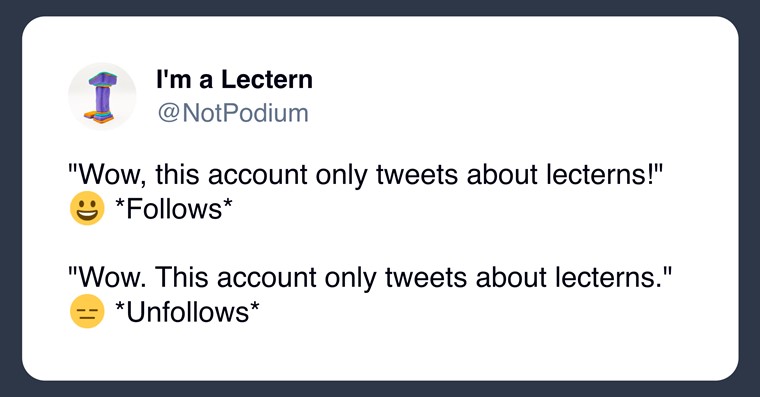
Some speakers can barely bring themselves to approach the thing. Others don't want to speak without it.
We've heard it called an abomination. And we've heard it called the speaker's best friend.
Yes, all this to-do is about a simple, vertical stand we at The Buckley School call a lectern and many people call a podium.
Whichever of those nouns you prefer, here's the question it often comes attached to: Should I use it?
Understand the benefits of using a lectern.
There are reasons you might gain by using a lectern.
Some are practical:
- It's a place to put your notes, out of view of your audience, keeping your hands free to gesture.
- A lectern can also hold a microphone, a laptop, and other devices that support your presentation.
Some are related to projecting confidence:
- For a nervous speaker, a lectern can provide a comforting home base—hiding your shaking knees and giving you a solid place to rest your hands.
- For a speaker who wants to convey authority, standing centered behind the lectern and grasping it signals you're the captain of the ship.
Know the messages using a podium can send.
If standing behind a lectern (or podium, if you prefer) can convey authority, it can also send other messages to an audience about you, the tone of an event, and even your willingness to connect with them.
Consider:
- A lectern is a barrier between you and the people you are speaking to.
- A lectern can suggest formality of speaker, occasion, or topic.
- A lectern can limit or contain your movement on stage or at the front of the room.
These considerations can be detrimental or advantageous, depending on what you're trying to achieve. Which leads us to suggest that you…
Make deliberate choices.
Many speakers use a lectern if they see one, assuming they have to. Or they speak without one when they'd prefer to have a podium on the premises.
Rather than let the room set-up direct your choices, think about what best supports your messaging goals.
Do you want to create an informal atmosphere or have a closer connection to your audience? You might choose to avoid the lectern.
Does your speech require gravitas? Would you like to distance yourself from a potentially hostile audience? The lectern might be just the thing you need.
And remember…
You can have your lectern and leave it, too.
A speaker can deliver parts of a presentation from the lectern and emerge from behind it to deliver other parts of that same presentation—a best-of-both-worlds situation for many.
For example, a speaker might open their remarks at the lectern, referencing their notes.
Then when it's time to relate a personal story, the speaker might come out from behind the lectern and connect more intimately with the audience.
When the speaker finishes that story, they can return to the lectern and resume the next part of their talk, again referencing their notes.
By using both, the speaker also gives audiences something they crave: variety.
"Common parlance has shown an increasing use of podium in North American English to describe a lectern."
– Wikipedia on the history of the podium
Is it a podium or a lectern?
We know from experience that if you ask a hotel to deliver a lectern to a conference room, they'll tell you they don't have one—but that they DO have a podium, if that helps.
Our founder Reid Buckley insisted we call it a lectern. He said a podium, like a podiatrist, was about supporting your feet.
We've been delighted to find there's a Twitter (X) account that agrees.

But if calling it a podium feels better to you, by all means go for it. The more important consideration is how you use the thing to help you make the impression you hope to achieve.
Learn more
See what you can learn about using the podium when Sen. Bernie Sanders speaks from a giant ice cream carton.
Find our how-to guide for using a lectern like a pro.
And if you're invited to speak, here's what to ask for—including a lectern, if that's what you need.






